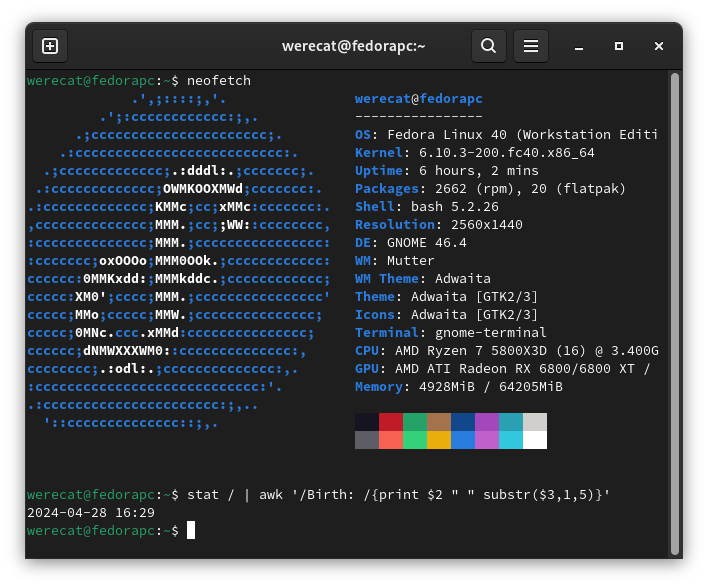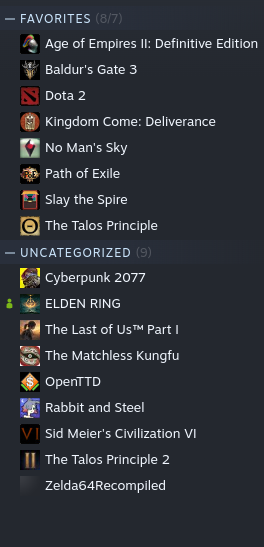I’ve tried to switch multiple times and always found or encountered some issue that got me back to Windows (on desktop PC).
Last year it was after 2 months on Fedora 38 KDE when I had enough with the KDE Window Manager acting weird and broken unusable VRR on desktop and some other smaller but daily issues that I went back to W11 on my PC.
I like GNOME over KDE and back then there was no VRR support on GNOME so I only had to stick with KDE, now it’s a different story.

I still have some minor annoyance which are probably solvable but I don’t know how as I didn’t put enough effort in finding solution.
Namely:
1.) Sometimes my 2nd monitor after boot remains blank and I have to unplug and plug back in the DP cable from the graphics card. Typically happens after a kernel update or restart but rarely on cold boot. I’ve seen others having this issue on Fedora40 but I haven’t seen any solution mentioned.
2.) Steam UI hangs up sometimes for several seconds when trying to navigate fast trough it and especially if it needs to pop a different window.
3.) GPU VRAM OC is completely busted and even doing ±1MHz will result in massive artifacting even on desktop, not a big deal but I would take the extra 5% boost I can have from VRAM OC on Windows :)
4.) After every Kernel update I have to run two commands to get my GPU overclock to work again. I haven’t figured out yet how to make a scrip that can read output from 1st command and copy it into 2nd command so I just do it manually every time which is roughly once a week.
5.) Free scrolling does not work in Chromium based browsers :( Luckily Vivaldi has some nice workaround with mouse gestures but I would still like free scrolling like on Windows.
And these are about the only annoyance I found worthwhile to mention.
Gaming works fine.

The apps I use typically work fine on Linux as well. Mangohud is amazing. No issues with audio unlike my last experience. Heck even Discord has no issues streaming video and audio now despite just using the web app. VRR despite being experimental works flawlessly on GNOME for me. I’m happy.


In all fairness, you are not using just “a desktop”. You are using a pretty specialized version of a desktop to run games, and so you’re requiring stuff that a “normal desktop” user don’t need: VRR, OC, weird mice, multiple monitors etc. Soon HDR too? Linux does perfectly the basics, but when you requiring such specialized stuff, don’t complain that an OS run by volunteers that have to reverse engineer hardware to make it work at all, doesn’t work to your liking. Keep it simple, and it will work. Get rid of the weird requirements. If that’s the stuff you want to run, then use Windows, because that hardware was designed to run on Windows, not on Linux. Linux will take years to support them to your liking. And by then, you’ll have moved on to newer hardware, where Linux won’t be supporting them well yet either. So either you’ll have to lower your specs, or you stay with the OS that they were designed for.
I wouldn’t call this a specialized setup. VRR has been there for almost 15years. I’ve dealt with VRR issues on Windows and they are still preset in some instances with mixed non-VRR and VRR monitor setups they just manifest differently on Linux due to different compositor. My experience last year on KDE 5 was fine in games and it was on desktop where VRR was causing me strange issues. Now I don’t have any issues on GNOME despite it being just and experimental feature still.
OC wise, yes. This is kinda niche and I’m glad that it at least works to some extent. I can squeeze more performance out of my GPU on Windows but even the SW that allows me to do it is not well known and very niche and finicky on Windows and for typical OC everything works fine on Linux except VRAM OC.
Weird mice… yes. After setting up my mouse on Windows I’ve saved my profile to the on-board memory and uninstalled that crappy SW so it’s not required for me to have my mouse usable.
HDR… I don’t really care about it right now. I’ve tried it and I still find SDR to look “better” in my subjective opinion.
I really have to disagree with your take that I would have to limit myself to “keep it simple” to use Linux since nothing is guaranteed and you will sooner or later run into some weird issue because of your setup despite thinking it’s “common enough”. Most of these requirements are not even weird in the slightest. And yes, I do appreciate the work that has been and is being done.
Volunteers? I thought fedora/red hat was one of the few professional Linux OSes with this particular distro family focusing in on servers and security?
I could be wrong though.
Red Hat Enterprise Linux is a professional Linux OS and a product of Red Hat. It costs money and the source code is only available to paying customers.
Fedora is a distro maintained by volunteers. It’s free and open source.
Both aren’t especially focusing on servers and security. RHEL is focusing on stability and long support duration for servers and workstations, Fedora is focusing on pushing new technologies for the desktop.